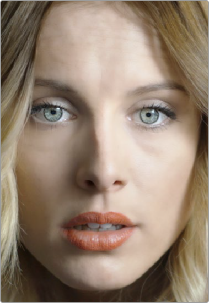

< Previous | Contents | Next >
— Saturation: This slider lets you adjust the intensity of lip color.
— Upper Lip Smooth: Lets you smooth out fine age lines that can appear above lips.
Blush Retouching
The parameters in this group let you modify the hue of the blush region of a subject’s cheek, letting you correct an unwise makeup choice, or push a subject’s blush color around to add makeup that wasn’t there.
— Hue: This slider lets you adjust the hue of the cheeks.
— Saturation: This slider then lets you intensify or remove blush color.
— Size: This slider lets you adjust the size of the blush area of the cheeks.
About Forehead, Cheek, and Chin Retouching
The next three groups of controls borrow a technique from portrait painters, who’ve long taken advantage of the “traffic light” approach to rendering skin hues, that observes that foreheads are often a bit yellow, the middle of the face is usually a bit red, and chins can be a bit green.
A combination of unequal sun exposure, capillary distribution, and follicle growth account for this, but the bottom line is that faces are seldom a single unified hue. This means that there may be a region of the face that would benefit from individual adjustment (cheeks that have gotten too much sun,
for example). But it also means that when you allow a bit of hue variation into your face grade, you can achieve a more naturalistic result.



TIP: For a variety of reasons, people are extremely sensitive to the hues of skin tone, so tiny variations that can be difficult to identify nevertheless have a significant impact on the resulting visuals. Unless you’re aiming to create a special effect, these controls are meant to be used sparingly.
TIP: For a variety of reasons, people are extremely sensitive to the hues of skin tone, so tiny variations that can be difficult to identify nevertheless have a significant impact on the resulting visuals. Unless you’re aiming to create a special effect, these controls are meant to be used sparingly.
TIP: For a variety of reasons, people are extremely sensitive to the hues of skin tone, so tiny variations that can be difficult to identify nevertheless have a significant impact on the resulting visuals. Unless you’re aiming to create a special effect, these controls are meant to be used sparingly.
![]()
(Left) A face graded with a single hue, (Right) A face graded with slight variation in the forehead, blush area, and chin